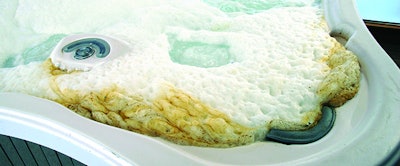
Customers who are new to hot tub ownership, and even longtime owners, are always surprised — and a bit skeptical — when told they should drain their spa as often as three months. "That sounds like a lot of work. Is that really necessary?" they ask. Well, in short, yes.
RELATED: How to Lengthen the Life of Spa Water
The average person brings 100 million bacteria into the water. These join other living organisms such as biofilm, parasites, virus, algae, mold, mildew and spores. Then we add swimmer waste such as blood, sweat and tears, urine, saliva, mucous and other bodily fluids. Finishing the soup are the man-made products that dissolve off the skin and hair, including creams, oils and lotion, soap, deodorants, makeup, hair products, perfumes and more.
A personal care product use survey of more than 2,300 people conducted by the Environmental Working Group and a coalition of public interest and environmental health organizations shows that the average adult uses nine personal care products each day with 126 unique ingredients. More than 25 percent of all women and one percent of all men use at least 15 products daily. Most of these personal care products are shed into the water upon immersion. (See references below.)
The organic material that gets into the spa is brought in by users. The average swimmer sweats about one pint per hour while swimming. However, the average spa user sweats up to three pints per hour at 102 degrees Fahrenheit.
There are 186 substances found in urine and sweat. Of these, 115 are nitrogenous substances, 14 are lipids, carbohydrates and organic acids, 22 are vitamins and metabolites and 35 are hormones.
The largest organic constituents of sweat are urea and creatinine. Reactions of chlorine or bromine with these compounds produce N-chloro or N-bromo compounds that we call chloramines, bromamines or combined chlorine or bromine. These chloramines or bromamines are persistent and require high levels of oxidizers to destroy them. They also interfere with chlorine, bromine and some other test methods.
Reactions of chlorine or bromine with some organics (called precursors or synthetic manmade chemicals) produce trihalomethanes such as chloroform, bromochloromethane, dibromochloromethane and bromoform. Chlorine and bromine also produce disinfection byproducts such as haloacetonitriles, cyanogen halides, halopicrines, haloacetic acids, chloral hydrates and haloketones.
RELATED: When It Comes To Water Care, Don't Think Of A Spa As Just A Small Pool
Chlorine and bromine in water eventually become chlorides and bromides in the water. They are then part of total dissolved solids. TDS levels in spa water quickly rise due to chemical consumption, water balance, chemical adjustment and spa users. We typically suggest that spa water be changed when TDS reaches 1,500 ppm more than starting TDS. However, many spas have TDS near 3,000 ppm and some as high as 5,000 ppm. It is mostly chloride and sodium.
There are perhaps as many as 22 tests that pool and spa stores can perform on pool and spa water. However, many of these are not necessary in normal situations. Of course there are many tests for THMs and DBPs and others that can be done in a water testing laboratory, but this kind of testing is not necessary.
All of these tests are not needed. However, they do indicate that these constituents may be in the water and may interfere with tests for other parameters. And indeed, some of these constituents may affect the performance of disinfectants and oxidizers.
Of the above tests, we need seven to maintain the spa water. Of these, TDS, calcium hardness and cyanuric acid change very slowly and are not very important once known and adjusted to proper recommended levels.
We are left with free chlorine (or bromine or PHMB), pH and total alkalinity. These change rapidly and are critical to water care. Therefore, they should be monitored by making tests on the water or by electronic sensors. How often to test the water is largely based on spa use. Large commercial or public spas with high numbers of users may require hourly testing.
Electronic water testing is usually continuous and may have the advantage of spa operator off-site notification via smartphone app. Chemical dispensing, then becomes important — and one needs to consider either manually dispensing chemicals or automating the dispensing process. We still need to know the levels for calcium hardness, cyanuric acid and TDS, but we do not need them in real time as they don't change often.
Total alkalinity is important, but currently, we're not able to test it electronically. Therefore, total alkalinity must be tested with a test kit or strips. Typically it is a liquid titration test. It measures carbonates (CO3-2), bicarbonates (HCO3–) and hydroxides (OH–) in water. Alkalinity in water is a pH buffer, that is, it prevents the pH from moving up or down. Too much alkalinity and the pH is hard to move (it requires more acid to lower). Too little alkalinity and the pH changes quickly when anything is added to the water. The proper level for total alkalinity in spas is 60 to 100 ppm with 80 to 90 ppm being the ideal.
pH should be kept between 7.2 and 7.8 with 7.5 being ideal. It should be noted that the pH of spas will usually rise due to aeration by therapy jets and air blowers, which causes CO2 outgassing.
Free chlorine levels should be 3 to 5 ppm; if using bromine, the levels should be 4 to 6 ppm.
Testing interferences may come from sulfates, borates, bromates, monopersulfate, quat algaecides, polymeric algaecides, polymeric flocculants, alum, ferric chlorides, silver algaecides, zinc, biguanides, percarbonates, enzymes and surfactants.
The water will also have what are called xenobiotics. This is a catchall term used to describe all the other things that don't fit into a category, and includes household cleaners such multipurpose cleaners, window and countertop cleaners and so on.
Xenobiotics include pharmaceutically active compounds (PhACs) and endocrine-disrupting chemicals (EDCs). Exogenous hormones (hormones produced outside the body) and one's own hormones are definitely biotic (caused or produced by living beings). Xenobiotics also include drugs both the legal kind that you get by prescription and the illegal type like cocaine, heroin, marijuana, meth, etc.
Pharmaceuticals (prescription medications) are formulated to be highly soluble and not readily degradable in the human digestive system. These properties make them persistent in water and not readily degraded by sunlight. Pharmaceutical residuals appear in urine and sweat as a product of their use and subsequent excretion. Other prescription preparations such as topical ointments and lotions that are used for dermal conditions are easily shed into the water upon immersion.
RELATED: Spa Maintenance in Cold Temps
When sewage was tested for the top 50 different prescription medications in studies done recently in Australia, all 50 drugs were present. It seems entirely possible then that these drugs are in spa water too. After all, these drugs are excreted in sweat and urine.
The ultimate recycling of water is a commercial recreational water facility (a public swimming pool, spa or hot tub). The water is sometimes used for years before draining or significant dilution. A residential spa is not the ultimate recycler but it is near the top of the list.
I am not sure whether the word "soup," "mixture" or "solution" is a proper word for the liquid that is in a well-used spa but I don't think we can exactly call it water either.
Of course, all of this information applies to pools as well but there is a huge difference if the ratio of gallons to people. That is, in a commercial pool there are likely 2,000 gallons or more per person and even more in a residential pool. (For example, two parents and two kids in a 15,000-gallon pool — in this case you have almost 4,000 gallons per person.)
Now consider four people in a 300-gallon spa, and you have one person to 75 gallons.
That relatively small liquid base, to which all the ingredients we've discussed are added — from live bacteria to creams and oils to disinfection byproducts — makes for a rather dense spa soup. Which is why, on a regular basis, you should dump the water and start from scratch.
ReferencesCenters for Disease Control and Prevention (CDC) (2003). Second National Report on Human Exposure to Environmental Chemicals. Available online at cdc.gov/exposurereport/2nd. Environmental Working Group (EWG), Healthcare Without Harm, and Women's Voices for the Earth (Houlihan, Brody, and Schwan) (2002). Not Too Pretty. Phthalates, beauty products, and the FDA. July 2002. Available online at www.ewg.org/issues/cosmetics and www.safecosmetics.org Environmental Working Group (2003). Brody Burden. Pollution in People. January 2003. Available online at www.ewg.org/reports/bodyburden/index.php. Thornton JW, McCally M, Houlihan J. (2002) Biomonitoring of industrial pollutants: health and policy implications of the chemical body burden. Public Health Rep 2002 Jul-Aug: 117(4):315-23. |
Comments or thoughts on this article? Please e-mail [email protected].










































